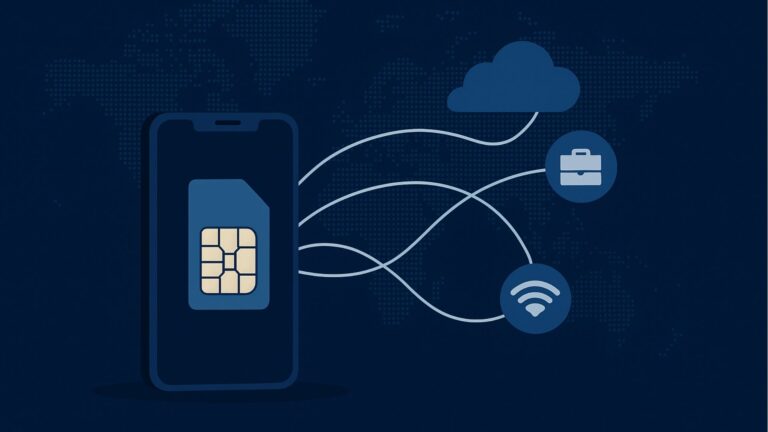Why Legacy SIM Cards Create Security Risks for Corporations
As businesses increasingly rely on mobile connectivity for secure communications, legacy SIM cards have quietly become a hidden vulnerability within corporate networks. Outdated authentication methods, lack of encryption, and physical SIM swapping risks expose companies to data breaches and identity theft. This blog explores how traditional SIM technology fails to meet modern cybersecurity standards—and why migrating to eSIM solutions offers stronger protection, better device management, and peace of mind for enterprise security teams.

In today’s digital first business world, secure connectivity is as critical as financial compliance or data privacy. Yet, many corporations still rely on legacy SIM cards—the small plastic chips that have historically connected mobile devices to cellular networks. Once the backbone of mobile connectivity, these SIM cards are increasingly out of step with modern security requirements. What may appear to be a harmless, inexpensive technology choice often masks a web of vulnerabilities that put corporations at serious risk of data breaches, fraud, regulatory penalties, and reputational damage.
This blog takes a deep dive into why legacy SIM cards are a weak link in corporate security infrastructures, exploring the technical vulnerabilities, real world attack scenarios, and broader implications for enterprise risk management. It also outlines why organizations must urgently modernize their connectivity strategy and what alternatives exist that can reduce exposure to today’s complex threat landscape.
The Corporate Dependence on Mobile Connectivity
Corporations today operate in a hybrid and borderless world. Employees connect on the go, from airports, coffee shops, hotel lobbies, and coworking spaces. From executives managing sensitive negotiations over messaging apps to field teams updating enterprise resource planning (ERP) systems in real time, mobile connectivity is deeply woven into business operations.
Legacy SIM cards were designed for personal communication decades ago, not for enterprise grade connectivity demands such as :
- Encrypted remote collaboration
- Zero trust security environments
- Secure authentication across devices and applications
- Real time compliance monitoring
- Global data governance
The mismatch between corporate needs and legacy SIM card capabilities sets the stage for escalating risk.
SIM Cards and the Illusion of Security
For years, SIM cards were considered “secure elements” because they operated within a closed environment controlled by mobile network operators. This perception led many corporations to treat SIMs as neutral, low risk tools. In reality, legacy SIM cards are increasingly easy targets for attackers due to several factors :
1. Physical Vulnerability :
A SIM card is removable. Lost or stolen devices often expose SIMs to tampering or unauthorized use.
2. Weak Authentication Protocols :
Older SIM standards rely on outdated cryptographic algorithms, many of which have been compromised.
3. Carrier Dependency :
Corporations are tied to the security practices of mobile network operators, which vary significantly across countries.
4. Lack of Centralized Control :
IT teams cannot remotely revoke, update, or monitor SIMs with the agility required for today’s threat environment.
These vulnerabilities create a false sense of safety. In reality, legacy SIMs open corporations to risks that extend far beyond simple data theft.
Key Security Risks Created by Legacy SIM Cards
1. SIM Swap Fraud and Account Takeover
Perhaps the most well documented risk is SIM swapping. Attackers convince or bribe telecom employees to reassign a victim’s phone number to a new SIM card under their control. Once successful, the attacker gains access to :
- SMS based two factor authentication (2FA) codes
- Bank accounts and financial systems
- Corporate email and collaboration platforms
- Cloud service logins
For corporations, this type of breach can escalate into multi million dollar financial fraud or intellectual property theft.
2. Outdated Encryption Standards
Legacy SIMs often rely on aging cryptographic protocols, which are susceptible to brute force attacks. Criminals who compromise SIM encryption can intercept or clone corporate communications, creating silent eavesdropping channels that are almost impossible to detect.
3. Lack of Remote Management
Corporations embracing remote and hybrid work need centralized oversight of their connectivity assets. Legacy SIM cards, however, remain static. If an employee leaves the company or a device is stolen, the IT team cannot instantly disable the SIM or reassign resources. This gap delays response times and extends the attack surface.
4. Insider Threat Amplification
Physical SIM cards are small, easily pocketed, and transferable. Rogue employees or contractors can exploit them to bypass corporate controls. Unlike modern digital credentials, SIMs leave limited audit trails, making malicious use difficult to trace.
5. Compliance and Regulatory Exposure
Data protection laws like GDPR, HIPAA, and PCI DSS emphasize secure handling of personal and corporate data. A breach facilitated by SIM card weaknesses can trigger hefty fines and compliance failures, particularly if regulators determine that a corporation neglected to upgrade insecure infrastructure.
6. Global Inconsistencies in Carrier Security
Multinational corporations face an added layer of complexity: telecom security standards vary worldwide. What may be a moderately secure SIM environment in one region could be dangerously outdated in another. Relying on legacy SIM cards creates uneven protection across global operations.
Real World Consequences of Legacy SIM Vulnerabilities
The theoretical risks of legacy SIM cards have materialized in alarming ways across industries :
- Financial Institutions : Banks have reported millions in losses after employees’ phone numbers were hijacked via SIM swaps, allowing attackers to approve fraudulent transfers.
- Healthcare Organizations : Sensitive patient data has been intercepted through weak SIM based authentication systems.
- Government Contractors : Compromised SIMs have opened backdoors into secure communication channels, threatening national security interests.
- Retail and E Commerce : Hackers exploiting SIM flaws gained control of customer loyalty accounts, leading to financial and reputational damage.
These examples highlight that no industry is immune. Any corporation relying on legacy SIM cards inherits a serious and often invisible liability.
The Broader Business Implications
While the immediate risks are technical, the broader implications extend to every corner of a corporation:
1. Financial Losses
Direct theft, fraud, and remediation costs.
2. Operational Disruption
Compromised devices can halt business continuity, especially for frontline employees.
3. Reputation Damage
Clients, investors, and partners lose trust after breaches linked to outdated practices.
4. Legal Liability
Failure to implement modern security can result in lawsuits and shareholder action.
5. Competitive Disadvantage
Organizations tied to legacy systems appear outdated, deterring modern partners and customers.
When seen holistically, legacy SIM cards are not merely a technical weakness; they are a strategic business risk.
Why Corporations Delay Transitioning
Despite clear risks, many corporations continue to rely on legacy SIM cards. Reasons include :
- Perceived Cost Savings : SIM cards appear cheap compared to newer alternatives.
- Change Resistance : IT departments accustomed to SIM based workflows resist modernization.
- Contractual Lock in : Long term deals with mobile carriers make transitions cumbersome.
- Underestimation of Risk : Leadership often lacks awareness of SIM related vulnerabilities until a breach occurs.
This inertia leaves organizations dangerously exposed at a time when attackers are increasingly exploiting SIM weaknesses.
The Case for Modern Alternatives
The solution lies in next generation connectivity, specifically eSIM technology and enterprise connectivity platforms that offer :
- Remote Provisioning : eSIMs can be activated, updated, or revoked instantly across global teams.
- Stronger Security Protocols : Enhanced encryption and authentication standards reduce exposure to known attacks.
- Centralized Management : IT departments gain real time visibility and control over corporate connectivity assets.
- Scalability for Global Teams : Seamless deployment across borders without relying on varying carrier standards.
- Audit Trails and Compliance Support : Digital credentials allow for better monitoring and compliance alignment.
By adopting eSIM based corporate solutions, organizations transform connectivity from a risk into a controlled, strategic asset.

Seamless eSIM Connectivity for Enterprises
Activate, manage, and scale eSIMs with ease.
Building a Secure Connectivity Strategy
To mitigate the risks of legacy SIMs, corporations must adopt a layered and proactive approach :
1. Audit Current SIM Deployments
Identify which employees and devices rely on outdated SIM cards.
2. Prioritize High Risk Roles
Executives, finance teams, and IT administrators are prime targets for SIM related attacks.
3. Deploy Modern Alternatives
Roll out eSIMs or secure enterprise platforms that support remote management.
4. Integrate Connectivity into Cybersecurity Strategy
Treat SIM security as part of the overall cybersecurity architecture.
5. Educate Employees
Train staff to recognize SIM swap attempts, phishing tactics, and suspicious carrier interactions.
6. Establish Incident Response Protocols
Ensure rapid action if a SIM compromise is suspected.
Transitioning from legacy SIM cards requires investment and strategic leadership, but the cost of inaction is far greater.
The Future of Corporate Connectivity
Looking ahead, the days of physical SIM cards in corporate environments are numbered. The rise of IoT devices, AI driven security systems, and borderless global teams makes it clear that traditional SIM cards cannot scale with corporate demands. Organizations that delay modernization risk falling behind not only in security but also in operational agility.
Forward thinking corporations are already embedding connectivity into their zero trust architectures, aligning mobile identity with enterprise authentication systems, and centralizing management via cloud platforms. In this future, connectivity is not just a utility but a critical security perimeter.
Conclusion
Legacy SIM cards once symbolized innovation but now represent vulnerability. For corporations, continuing to rely on them means exposing operations, data, and reputation to avoidable risks. From SIM swap fraud to outdated encryption, the security flaws are too severe to ignore.
Modern alternatives like eSIM technology empower corporations with control, scalability, and robust security, aligning mobile connectivity with the realities of today’s threat landscape. By proactively phasing out legacy SIM cards, businesses safeguard not just their data but their financial stability, compliance posture, and long term competitiveness.
In an era where trust and security underpin every corporate interaction, organizations must recognize that the age of the plastic SIM is over—and the future belongs to secure, digital first connectivity.



 8 min read
8 min read





